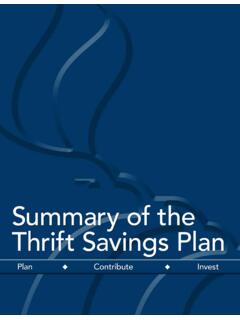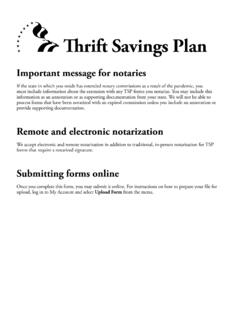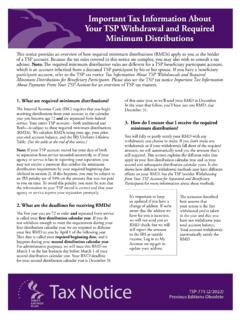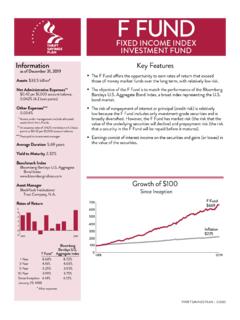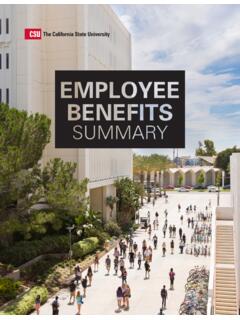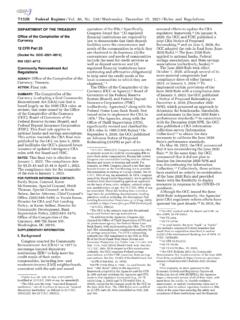Transcription of In-Service Withdrawals - Thrift Savings Plan
1 In-Service Withdrawals Financial Hardship Age-Based 591/2 . Table of Contents Before You Make an In-Service Withdrawal.. 1. Consequences of Making an In-Service Withdrawal.. 2. Financial Hardship In Service Withdrawals .. 4. Acceptable Reasons for Making a Financial Hardship Withdrawal.. 4. Negative Cash Flow.. 4. Extraordinary Expenses.. 5. TSP Rules for Making a Financial Hardship Withdrawal.. 6. How to Apply for a Financial Hardship Withdrawal.. 7. Age-Based In-Service 591/2 Withdrawals .. 9. TSP Rules for Making an Age-Based Withdrawal.. 9. How to Apply for an Age-Based Withdrawal.. 11. How In-Service Withdrawals Are Disbursed .. 12. Additional Points to Note.. 14. Taxes.. 14. Account Holds .. 14. Spouses' Rights .. 15. Summary of In-Service Withdrawal Rules .. 16. Contact Information.. inside back cover Before You Make an In-Service Withdrawal An In-Service withdrawal is a withdrawal that you make from your Thrift Savings plan (TSP) account while you are still actively employed in federal civilian service (CSRS or FERS) or the uniformed There are two types of In-Service Withdrawals : financial hardship Withdrawals and age- based 591/2 Withdrawals .
2 Note: You cannot make an In-Service withdrawal from a beneficiary participant account. (A beneficiary participant account is a TSP account that is inherited by the spouse of a deceased TSP participant.). Before making an In-Service withdrawal, keep in mind that the TSP is a retirement Savings and investment plan designed to help you save for your future. If you are covered by the Federal Employees' Retirement System (FERS) or are a member of the uniformed services covered by the Blended Retirement System (BRS),2 the TSP is a critical component of your federal retirement benefits and may represent a significant part of your retirement income. Before you decide to withdraw money from your account while you are still employed, carefully consider the impact of your decision on your future well-being. 1 CSRS refers to the Civil Service Retirement System, including CSRS Offset, the Foreign Service Retirement and Disability System, and other equivalent government retirement plans. These federal civilian employees were hired before January 1, 1984.
3 FERS refers to the Federal Employees Retirement System, the Foreign Service Pension System, and other equivalent government retirement plans. These federal civilian employees were hired on or after January 1, 1984. For TSP purposes, members of the uniformed services include members of the Army, Navy, Air Force, Marine Corps, Coast Guard, Public Health Service, and the National Oceanic and Atmospheric Administration, as well as members of the Ready Reserve, including the National Guard. If you are both a federal civilian employee and a member of the uniformed services, you may have two separate accounts. The information in this booklet applies to each account separately. 2 The Blended Retirement System is for members of the uniformed services who began service on or after January 1, 2018, and others who opted into the system. 1. Consequences of Making an In-Service Withdrawal An In-Service withdrawal affects your ability to accumulate Savings and, in some cases, to defer taxes. This is because of the following: When you make an In-Service withdrawal, you permanently reduce your TSP account by the amount you withdraw, and you also give up any future earnings on that amount.
4 Once we process your In-Service withdrawal, you cannot return or repay the money to your account, and you cannot convert your withdrawal to a loan. You must pay federal and, in some cases, state income taxes on the taxable portion of your withdrawal. If you make a financial hardship withdrawal before age 59 , you may also have to pay a 10% early withdrawal penalty tax. Note: You do not have to pay federal taxes on any tax-exempt or Roth contributions that are included in your withdrawal. But you do have to pay federal taxes on any earnings on these contributions if you have not met the conditions necessary for a qualified You should think about these consequences before making an in-serv ice withdrawal. If you are in pay status and are eligible for a TSP loan, you may want to consider that option because it has certain advantages over a withdrawal. When you take a loan, it is not taxable income. Also, you repay your own TSP account for the amount of the loan (plus interest) and therefore continue to accrue earnings on the money you borrowed after you pay it back.
5 For more information about TSP loans, read the booklet Loans, which is available at or by calling the ThriftLine. 3 Roth earnings become qualified ( , paid tax-free) when the following two conditions have been met: (1) 5 years have passed since January 1 of the calendar year in which you made your first Roth contribution, and (2) you are age 59 or older, permanently disabled, or deceased. Note: We cannot certify to the IRS that you meet the Internal Revenue Code's definition of disability when your taxes are reported. Therefore, you must provide the justification to the IRS when you file your taxes. 2. The chart below compares how taking a TSP loan or making an in-serv ice withdrawal would affect your account. In-Service . LOAN. WITHDRAWAL. Cost to You $50 loan fee Retirement Savings permanently reduced by amount of withdrawal No future earnings on amount withdrawn Effect on None (unless loan is not Immediate tax liability (unless Taxes paid back and a taxable age-based withdrawal is distribution is declared*) transferred to an IRA or eligible employer plan ).
6 Possible additional 10% early withdrawal penalty tax Effect on No earnings on amount of No earnings on amount Earnings loan until funds are repaid withdrawn * When a taxable distribution is declared, the Internal Revenue Service (IRS) considers the unpaid balance (including any accrued interest) of the loan to be taxable income. 3. Financial Hardship In Service Withdrawals A financial hardship withdrawal is a withdrawal you make while still employed because of genuine financial need. You must pay income tax on the taxable portion of your financial hardship withdrawal, and you may also have to pay a 10% early withdrawal penalty Acceptable Reasons for Making a Financial Hardship Withdrawal This section of the booklet explains the acceptable reasons for making a financial hardship withdrawal. These include negative cash flow and extraordinary expenses. Our online tool for requesting a hardship withdrawal provides a worksheet that helps you determine the amount of your hardship. Negative Cash Flow You have negative cash flow if your net income is less than your expenses on a recurring basis.
7 If you believe you have negative monthly cash flow, use the worksheet you'll find in our online tool for hardship Withdrawals to determine how much it is. To get an accurate answer using the worksheet, you'll need to have the following information: Gross monthly income. Include your monthly pay before taxes and other deductions and any other monthly income, such as child support. Include your spouse's income as well. The online worksheet needs this total and the number of people in your family to determine a reasonable level of monthly expenses. Net monthly income. Start with your gross monthly income and subtract the monthly federal paycheck deductions, such as tax withholding, Social Security, federal retirement deductions, etc. 4 For more information, see the TSP tax notice Important Tax Information About Payments From Your TSP Account, available at 4. Total fixed monthly expenses. Include your rent or mortgage; real estate tax; your homeowner's or renter's insurance; monthly household utilities; necessary household help due to illness or injury; and any expenses you pay for alimony, maintenance, or child support.
8 You should also include any installment loan payments other than those related to a TSP loan. Do not include credit cards or charge accounts or any interest charges on them. Extraordinary Expenses Extraordinary expenses that are not part of your regular monthly cash flow can also contribute to your financial hardship. You may only include expenses that you have not yet paid and that will not be reimbursed to you. The following are extraordinary expenses you can include in your financial hardship: Eligible medical expenses including the following: Any medical expense that you have not yet paid that would be eligible for deduction on your federal income tax return. The expense must have been incurred as the result of a medical condition, illness, or injury to you, your spouse, or individuals you can claim as dependents (individuals you can claim as dependents for federal income tax purposes at the time you request your financial hardship withdrawal). Expenses that you have not yet paid for household improvements needed because of a medical condition, illness, or injury to you, your spouse, or your dependents.
9 Examples include the installation of structural improvements such as wheelchair ramps, railing and support bars, modified doorways and stairways, or elevators for people with heart conditions. Eligible personal casualty losses including damage, destruction, or loss of property resulting from an identifiable event that is sudden, unexpected, or unusual. Such losses can be the result of earthquakes, hurricanes, tornados, floods, storms, fires, or similar causes. They can also be the result of property theft or automobile accidents that are not caused by your willful negligence or willfully destructive act. 5. Generally, eligible costs of repairs and replacement of personal casualty losses are those that are eligible for deduction on your federal income tax return (without taking into consideration the IRS limits on income, the fair market value of the property, or the number of events causing the casualty loss). However, eligible personal casualty losses do not include loss of deposits when a bank or other financial institution becomes insolvent or bankrupt.
10 Losses to a business or income-producing property (even though such losses are deductible for federal income tax purposes); or damage from normal wear and tear, such as damage or destruction caused by termites or moths or progressive deterioration of your property. Eligible legal expenses, limited to unpaid legal fees and court costs related to a separation or divorce from your spouse. Legal expenses that cannot be used to justify a financial hardship include the following: Court-ordered payments to a spouse or former spouse and child support payments. However, if you are making a financial hardship withdrawal because of negative cash flow, such payments should be included in your calculation of expenses. Costs of obtaining prepaid legal services or other coverage for legal services. TSP Rules for Making a Financial Hardship Withdrawal The following rules apply to making a financial hardship withdrawal: You cannot withdraw less than $1,000. The money may only be taken from your own contributions (including money you may have transferred into the TSP from IRAs or eligible employer plans) and the earnings on those contributions.
